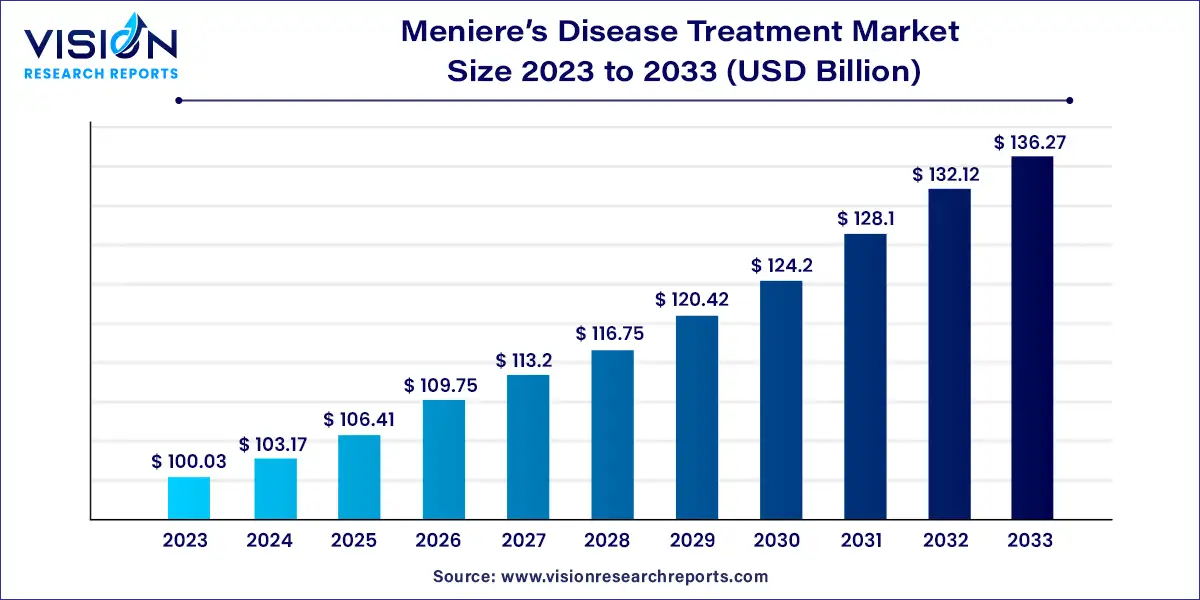The global Meniere’s disease treatment market size was estimated at USD 100.03 billion in 2023 and it is expected to surpass around USD 136.27 billion by 2033, poised to grow at a CAGR of 3.14% from 2024 to 2033. Meniere’s disease, a chronic inner ear disorder, is characterized by vertigo, tinnitus, hearing loss, and a sensation of fullness in the ear. The Meniere’s Disease Treatment Market encompasses various therapeutic approaches aimed at managing and alleviating these symptoms. As awareness and diagnosis of the disease improve, the market for treatment options continues to grow.

The Meniere’s disease treatment market is experiencing robust growth driven by an increasing prevalence of Meniere’s disease, influenced by an aging global population and environmental factors, is driving demand for effective treatment solutions. Advances in medical research are also playing a crucial role, as innovative drug therapies and surgical techniques continue to emerge, offering new hope for patients. Improved diagnostic tools and a growing awareness of the disease further contribute to market expansion by facilitating earlier and more accurate diagnoses. Additionally, the integration of digital health technologies and personalized medicine is enhancing patient management and treatment efficacy, creating new opportunities within the market.
Anti-vertigo drugs, such as antihistamines and anticholinergics, are designed to alleviate the debilitating episodes of vertigo associated with Meniere’s disease. These medications work by stabilizing the vestibular system and reducing the sensation of spinning or dizziness, thereby improving the quality of life for affected individuals.
Additionally, diuretics are commonly prescribed to help manage the disease by reducing fluid retention in the inner ear. The primary aim of diuretics is to lower the endolymphatic pressure within the inner ear, which is believed to contribute to the symptoms of Meniere’s disease. By decreasing the volume of fluid, these drugs can help mitigate vertigo and hearing loss, providing a valuable component of a comprehensive treatment regimen. Both anti-vertigo drugs and diuretics are integral to the therapeutic strategies employed in managing Meniere’s disease, each addressing different aspects of the condition to offer symptomatic relief and improve patient outcomes
Steroid injections, such as intratympanic steroids, are administered directly into the middle ear to reduce inflammation and provide relief from vertigo and hearing loss. By delivering corticosteroids locally, these injections aim to decrease the swelling and pressure in the inner ear, which can help alleviate the severity and frequency of Meniere’s disease symptoms.
On the other hand, gentamicin injections involve the use of an antibiotic delivered directly into the inner ear to selectively damage the balance function while preserving hearing. This treatment works by reducing the excessive endolymphatic pressure and controlling severe vertigo through the chemical ablation of vestibular hair cells. Both steroid and gentamicin injections are considered more aggressive approaches, usually reserved for patients who do not respond to conservative treatments. These injections offer targeted interventions that can significantly improve patient outcomes by addressing the underlying mechanisms contributing to Meniere’s disease symptoms.
Hospitals and clinics are often the primary settings where patients initially seek diagnosis and treatment for Meniere’s disease. These facilities provide a range of diagnostic services, including advanced imaging and auditory tests, as well as various treatment options such as pharmacological therapies and surgical interventions. The broad scope of services offered by hospitals and clinics makes them central to the comprehensive care of Meniere’s disease patients.
Specialty centers, on the other hand, focus specifically on conditions related to ear, nose, and throat (ENT) or vestibular disorders. These centers offer specialized expertise and advanced treatment options tailored to the needs of individuals with Meniere’s disease. They are equipped with state-of-the-art technologies and highly trained professionals who provide targeted treatments, including vestibular rehabilitation therapy and advanced surgical procedures. Both types of facilities are integral to the Meniere’s Disease Treatment Market, contributing to improved patient outcomes through their distinct but complementary roles in disease management.
In North America, the market is characterized by advanced healthcare systems, high levels of research and development, and substantial investments in medical technologies. The United States and Canada have well-established frameworks for diagnosing and treating Meniere’s disease, leading to a significant market share in this region.
Europe similarly demonstrates a robust market presence, driven by an extensive network of specialized medical centers, high awareness levels, and supportive healthcare policies. Countries such as Germany, the United Kingdom, and France are notable contributors, benefiting from their advanced healthcare infrastructure and active research communities.
In the Asia-Pacific region, the Meniere’s Disease Treatment Market is experiencing rapid growth due to increasing healthcare access, rising disposable incomes, and expanding awareness of vestibular disorders. Emerging economies like China and India are seeing heightened demand for treatment options as healthcare systems continue to develop and improve.
Latin America and the Middle East & Africa represent smaller but growing markets, with increasing investments in healthcare infrastructure and efforts to improve access to specialized care. While these regions face challenges such as varying levels of healthcare development and limited resources, they are nonetheless showing promising growth trends as healthcare systems evolve and patient awareness increases.
By Drug
By Injections
By Surgery
By End User
By Region
 Cross-segment Market Size and Analysis for
Mentioned Segments
Cross-segment Market Size and Analysis for
Mentioned Segments
 Additional Company Profiles (Upto 5 With No Cost)
Additional Company Profiles (Upto 5 With No Cost)
 Additional Countries (Apart From Mentioned Countries)
Additional Countries (Apart From Mentioned Countries)
 Country/Region-specific Report
Country/Region-specific Report
 Go To Market Strategy
Go To Market Strategy
 Region Specific Market Dynamics
Region Specific Market Dynamics Region Level Market Share
Region Level Market Share Import Export Analysis
Import Export Analysis Production Analysis
Production Analysis Others
Others